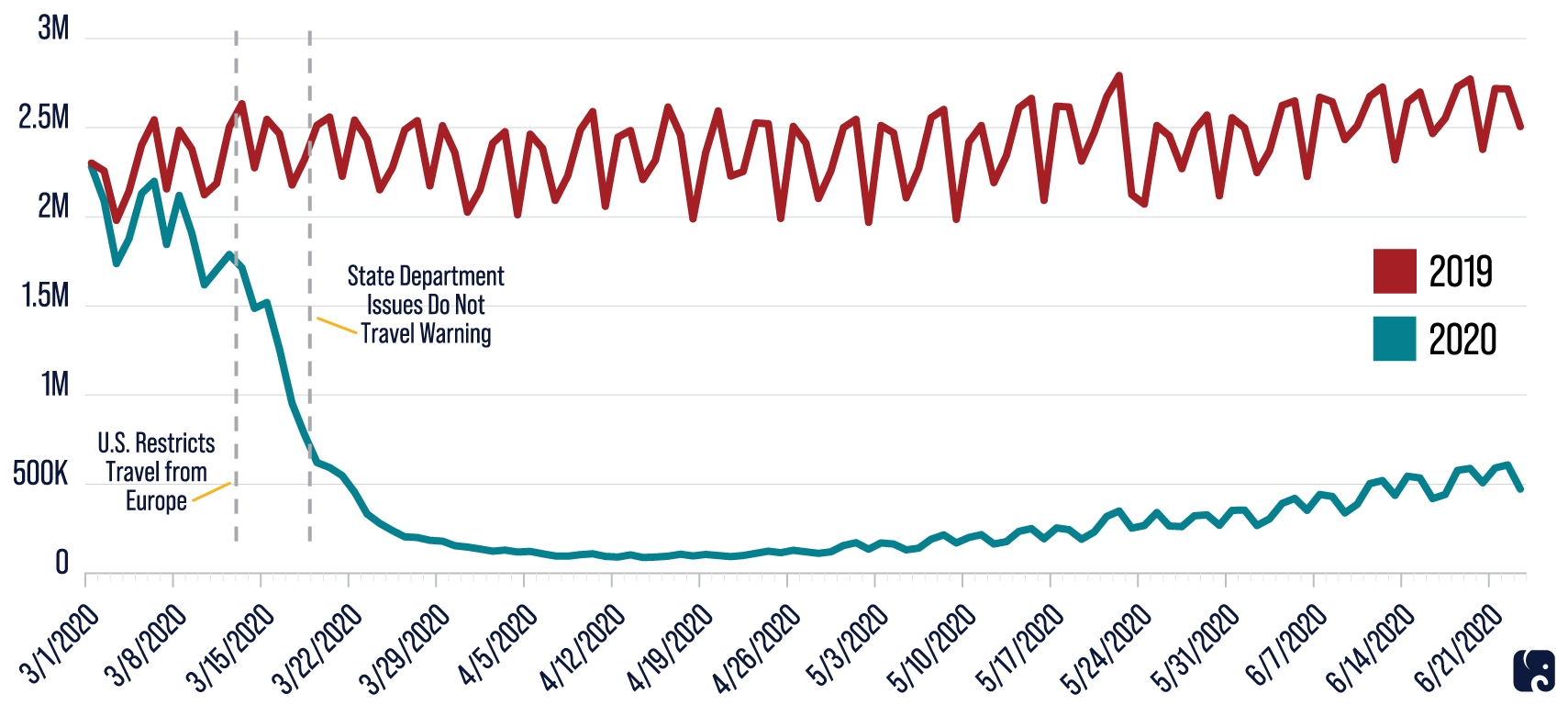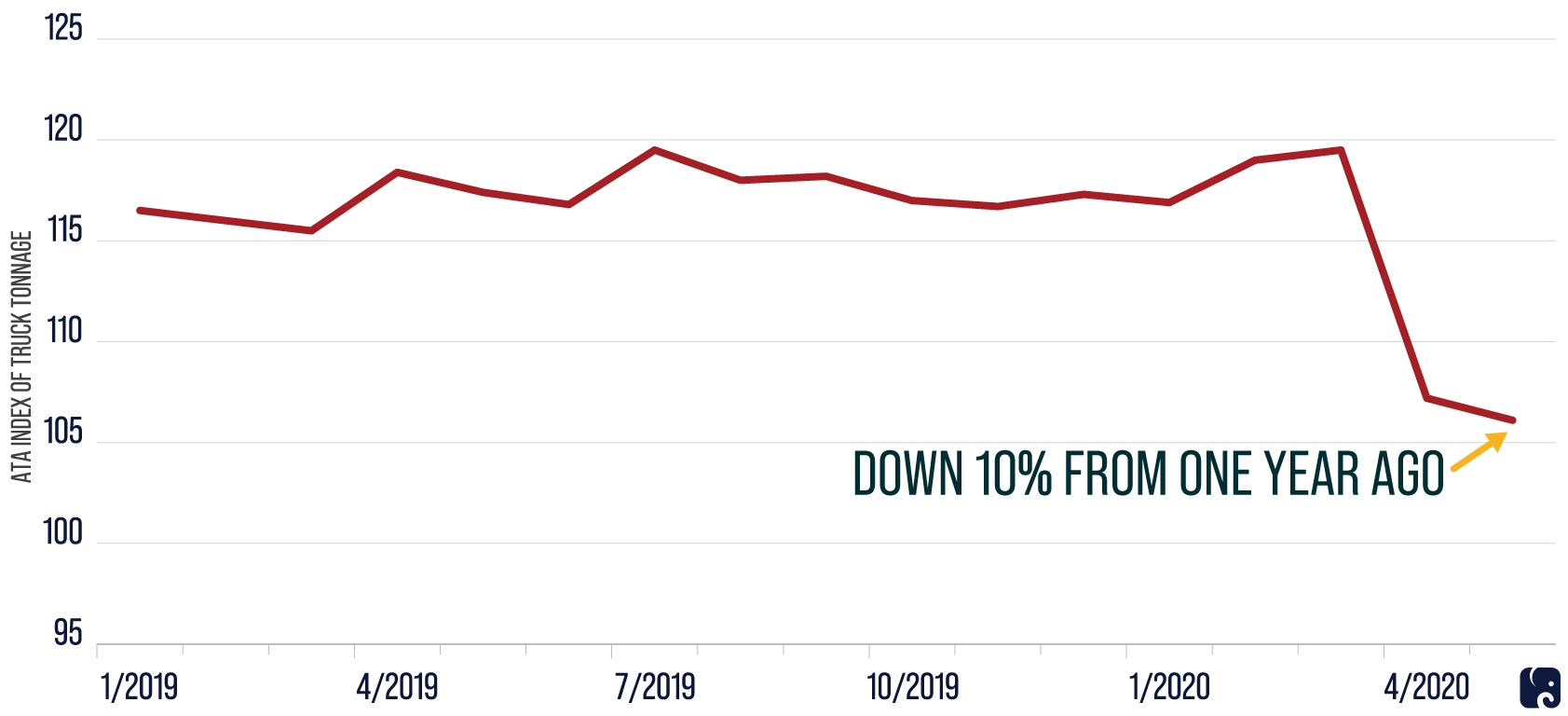How COVID-19 is Affecting Transportation
KEY TAKEAWAYS
- Travel in the U.S. collapsed due to the COVID-19 public health emergency.
- Commercial transport also has declined, though less dramatically than passenger travel.
- The transportation industry is attempting to adapt by putting new safety measures in place that address public health and safety concerns.
Travel in the U.S. fell sharply and quickly, amid COVID-19 travel warnings and state orders telling people to stay home. One survey found nearly half of Americans had canceled travel plans for the summer. The U.S. Travel Association expects the number of domestic trips to decrease by 30% compared to last year. The transportation industry is gradually recovering as states reopen, but many people remain unemployed and unable to take leisure trips and others continue to telecommute, reducing the demand for transit and other travel options.
Airport Passenger Screenings Plummeted

Trips decline sharply
In 2019, the Transportation Security Administration screened more than 2 million air travelers on a typical day. After President Trump declared the coronavirus to be a national emergency on March 13, and the State Department warned people not to travel internationally on March 19, the number of people travelling by air dropped dramatically. On April 14, TSA screened fewer than 88,000 passengers. Thousands of flight cancellations have delayed or upended travel plans. In early May, the industry group Airlines for America told the Senate Commerce Committee that the airlines it represents were carrying an average of 17 people on each domestic flight, despite grounding more than 3,000 planes and cutting schedules sharply. As of June 21, the number of people flying domestically had increased slightly but was still down 78% from last year.
Commuter rail systems like the Virginia Railway Express saw their ridership plunge when many people began working from home. The Metra commuter line in Chicago said in April that it could lose more than $500 million in revenue this year – fares account for about half of the agency’s operating budget. The New York City subway cut service as ridership fell by more than 90%. Bus systems also saw ridership drop, but not as steeply. The number of rides in Baltimore dropped by 50% from February to April. Cuts to public transportation service and hours of operation meant longer or less reliable commutes, and some cities are providing free on-demand trips for essential workers if public transit is unavailable.
A Decline in Truck Freight

Source: American Trucking Associations
On the roads, less commuting and fewer personal trips has led to a steep drop in traffic. While trucks have moved large quantities of groceries and other essential goods during the pandemic, freight traffic also has declined. In May, the American Trucking Associations’ index that tracks the amount of freight its members carry was down by around 10% from a year earlier. Less driving – whether commercial or passenger – means lower fuel consumption and lower collections from federal and state fuel taxes that fund transportation projects. This may exacerbate the cash problems in the federal Highway Trust Fund, which already was expected to have shortfalls beginning in 2021. The programs it pays for also need to be reauthorized by September 30.
Some cruise lines had already voluntarily stopped sailing when the government issued a no-sail order on March 14. Ocean carriers canceled scheduled trips due to supply chain disruptions and lower consumer demand. The American Association of Port Authorities said it had “seen containerized cargo decline by 18% in March over the same period in 2019.”
adapting to keep people safe
The transportation industry has begun to put safety measures in place to make customers more comfortable traveling in confined spaces again. Major airlines now require face coverings for passengers and employees who interact with them. Some are scaling back their food and beverage service to reduce contact between passengers and flight attendants, and several have set up new boarding procedures to avoid crowded aisles. Critics – including the director of the Centers for Disease Control and Prevention at a Senate hearing on June 30 – have noted varying degrees of compliance with the new safety measures. The bus systems in Washington, D.C., and Atlanta require people to use the rear doors so they interact less with the driver, and they are waiving the fares. Amtrak is allowing fewer people to book seats and has put signs in some train stations indicating safe distances for those waiting in line. The Pennsylvania Turnpike is no longer accepting cash at tollbooths in order to reduce recirculating germs. These measures that limit capacity or suspend payment are safety precautions, but they also reduce revenue, which could affect the industry’s recovery.
Federal assistance
The Coronavirus Aid, Relief, and Economic Security Act that Congress passed in late March provided money to help the transportation industry maintain operations and retain workers. The aid included $10 billion in grants to airports; $1 billion to Amtrak; $100 million to TSA for cleaning security checkpoints and other costs; and $25 billion in formula grants to state and local mass transit agencies. The law also allowed the Treasury to lend up to $25 billion to passenger airlines, airline travel agencies, and aviation repair stations, and up to $4 billion to cargo airlines. Borrowers must retain, through September 30, at least 90% of the employees they had on March 24. Passenger and cargo airlines, as well as contractors like those that cater food or clean planes, also have received payments from a separate $32 billion payroll support program in the law.
On June 12, the federal government said it would send 100 million face coverings to airports, transit agencies, and Amtrak to give to passengers. The Federal Motor Carrier Safety Administration helped distribute face coverings to commercial drivers. The Federal Highway Administration has urged state agencies to keep rest stops open for truck drivers, and it allowed food trucks to operate at rest stops along the interstate, since so many restaurants had closed. The agency also temporarily exempted truck drivers carrying certain goods from rules on hours of driving and rest breaks.
outlook for the industry
State and local economies are reopening, but it is unclear when commuting and other travel will return to prior levels. Because the pandemic had a less severe impact on the trucking industry, some expect it may recover faster than harder-hit industries. Some businesses are telling their workers to continue telecommuting for at least a few months, and others are looking to make it permanent for some employees. This could affect the outlook for commuter rail and transit agencies. Interest in RV sales and rentals has surged recently, and some in the travel industry think people may choose to travel closer to home in their own vehicles or go on short flights before taking cruises or longer plane rides. Airlines have seen traffic begin to increase, but whether business travel will pick up and passengers will take a chance on travelling during the winter holidays may depend on whether vaccines, treatments, and testing are widely available by then.
Next Article Previous Article
